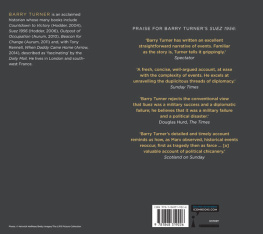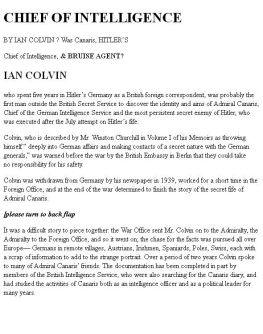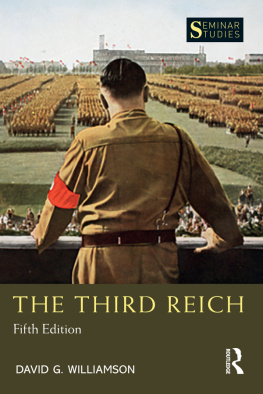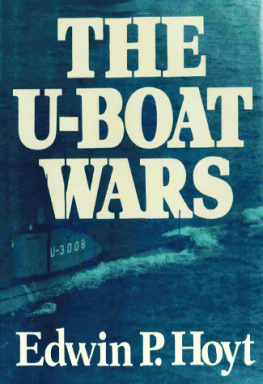KARL DOENITZ
AND THE LAST DAYS OF THE THIRD REICH
KARL DOENITZ
AND THE LAST DAYS OF THE THIRD REICH
BARRY TURNER

First published in the UK in 2015 by
Icon Books Ltd, Omnibus Business Centre,
3941 North Road, London N7 9DP
email:
www.iconbooks.com
Sold in the UK, Europe and Asia
by Faber & Faber Ltd,
Bloomsbury House, 7477 Great Russell Street,
London WC1B 3DA or their agents
Distributed in the UK, Europe and Asia
by TBS Ltd, TBS Distribution Centre, Colchester Road
Frating Green, Colchester CO7 7DW
Distributed in Australia and New Zealand
by Allen & Unwin Pty Ltd, PO Box 8500,
83 Alexander Street, Crows Nest, NSW 2065
Distributed in South Africa by Jonathan Ball,
Office B4, The District, 41 Sir Lowry Road,
Woodstock 7925
Distributed in Canada by Publishers Group Canada,
76 Stafford Street, Unit 300
Toronto, Ontario M6J 2S1
Penguin Books India,
7th Floor, Infinity Tower C, DLF Cyber City,
Gurgaon 122002, Haryana
Distributed to the trade in the USA
by Publishers Group West,
1700 Fourth Street, Berkeley, CA 94710
ISBN: 978-184831-922-6
Text copyright 2015 Barry Turner
The author has asserted his moral rights.
No part of this book may be reproduced in any form, or by any means, without prior permission in writing from the publisher.
Typeset in Dante by Marie Doherty
Printed and bound in the UK by
Clays Ltd, St Ives plc
LIST OF ILLUSTRATIONS AND MAPS
Plate section
Images from ullstein bild unless otherwise specified
Maps in text
FOREWORD
by Admiral of the Fleet Lord Boyce
B arry Turners Karl Doenitz and the Last Days of the Third Reich provides a masterly summation of a confusing period in the closing stages of the Second World War. It switches successfully from describing high-level strategic considerations and interplay within the Nazi and Allied leadership, to the harrowing details of individuals first-hand experiences of war at the bottom of the hierarchical structure, with cameos of heroism, cowardice, brave offence and defence.
Captivating stories and insights into the personalities of the main players are unfolded and nowhere is this truer, of course, than in the case of Doenitz himself. It is here that, as a submariner, I found myself most intrigued. The author has captured very well the ethos of the submarine world and its effect on the individual who lives, or has lived, within it; and the make-up of Doenitzs personality, his deep professionalism, loyalties and values, reflect this admirably. In particular, and as the book quotes him:
I had been fascinated by that unique characteristic of the submarine service, which requires a submariner to stand on his own feet and sets him a task in the great spaces of the oceans, fulfilment of which demands a stout heart and ready skill; I was fascinated by that unique spirit of comradeship engendered by destiny and hardship shared in the community of a U-boat crew, where every mans well-being was in the hands of all and where every single man was an indispensable part of the whole.
What he learnt about the effectiveness of submarine warfare in the First World War was to play a major part in his thinking 20 years later; and his own personal belief in the effectiveness of the submariner, hardened by his improbably surviving the sinking of the U-boat under his command in 1918, can be seen in the attention he lavished on the personnel in that branch of the Kriegsmarine.
His judgement on submarine warfare was sound, and the success he had in strangling the supply lines across the Atlantic nearly brought Great Britain to its knees in 194243 and threatened to do so again when the new generation of technologically superior U-boats was deployed in early 1945. I was interested to read of the difficulties Doenitz had in trying to get more support from the Luftwaffe for his submarine deployments not too dissimilar from the frustrations the Royal Navy had in getting RAF support!
Having provided the nature of the background that shaped the man, and after an opening chapter on the chess-like moves for the transfer of power following Hitlers death, the narrative of unfolding events in the first half of 1945 leading up to the end of the war and immediate post-war activity can be characterised as falling broadly into four parts: action at sea in the Baltic, including Operation Hannibal; the final throes of the war on land, including the machinations of both Allied and German senior commanders; negotiations for ending the war; and Doenitzs actions and ultimate fate post war.
The importance to Germany of the Baltic providing as it did the vital supply lines to keep the all-important, powerful and potentially war-winning industrial machine running is strongly portrayed, as is its use to facilitate probably the biggest ever evacuation by sea: Operation Hannibal a story probably unknown to most. The huge scale of this operation eclipses Dunkirk and the books vivid and contemporaneous descriptions of such events as the loss of the Wilhelm Gustloff and 9,000 lives paint a chilling picture. Doenitz had a driving, passionate and humanitarian-based determination to save as many as possible of those in the Baltics eastern regions trying to escape the jaws of the Bolshevik advance as it swallowed up the Baltic ports with horrendous savagery; and his belief in the importance of the evacuation in spite of Hitlers indifference, if not objections is later shown to be an underlying theme for his actions after the Fuhrers death, as he tried to shape circumstances that might allow German and other refugees to avoid capture by the Soviets as they advanced through Germany from the East.
That advance, together with the similar moves by the Western Allies from the Channel and their race to cross the Rubicon-like Rhine and to reach Berlin against the desperate and unexpectedly strong defence by the Wehrmacht, as well as the effect on the civilian population, and the tensions and antipathies between key players on both sides, forms the second part and makes a story in itself once again brought to life with recollections of individuals there at the time. Massive movements, massive loss of life and massive interplay of politics that would have far-reaching consequences make absorbing reading and lead the reader well into the other two parts of the narrative.
The descriptions of these the manoeuvrings around Doenitz reluctantly assuming the mantle of Fuehrer, the negotiations leading to German surrender and the final scenes played out in the court at Nuremberg provide the final pieces of evidence from which the reader can form a judgement about whether Doenitz played his war-leader part in the conflict fairly. The author argues that Doenitzs incarceration as a convicted war criminal was more about politics than any crime committed, and in this connection it is interesting that the First Sea Lord supported Doenitzs appeal against conviction, and that the Royal Navy was represented at his funeral in 1980. Doenitz was a professional warrior who had total belief in his Kriegsmarine keeping it, and himself, largely free from Nazi ideology and an ingrained loyalty to his country. He fought a hard war, but no harder than his opposing admirals and generals, and with no worse excesses although an accusation of uncritical devotion to a political cause would not be unfair.
Like old soldiers, Doenitz faded away after his imprisonment, never looking for the leadership role many expected and hoped he would take up again. But he left his own mark on European history, not least his anticipation of what he saw as the main threat to world order Soviet expansionism; and his belief and focus on the effectiveness of the submarine as a war-fighting, potentially war-winning, machine in maritime strategy is as pertinent today as it was 75 years ago.
Next page














